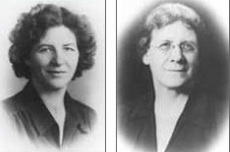Meyers and Briggs Typology
Theory Overview
The Myers-Briggs Type Indicator was developed by mother-daughter pair Isabel Briggs Meyers and her mother Katharine Briggs to apply the different psychological types of C.G. Jung and give them an applied purpose. The Myers-Briggs Type Indicator, also known as the MBTI is frequently used in university career and counseling centers to help college students understand their traditional personality types.
The inventory addresses the preferences of Jung's four dichotomies, along with the identification and description of the sixteen possible personality types that the four dichotomies can combine to create. The first distinction is between extraversion (E) and introversion (I). Extraverts gain their energy from interacting with others, while introverts gain energy from their inner world Secondly, sensing and intuition deal with how people obtain information. Sensing (S) deals with information that is received through the five senses, whereas, intuition (N) refers to the patterns that present themselves in information. Thirdly, some people make decision based on thinking (T), while other make them based on feeling (F). thinking is using logic in decision making, whereas feeling uses a less rational and more circumstantial approach. Lastly, when dealing with structure of events, some people prefer to have things planned, which refers to judging (J), while others desire to stay flexible and spontaneous, which refers to perceiving (P). There can be any combination of these four dichotomies (as represented by the specific letters), and each person relates to them on a continuum (Myers-Briggs Foundation)
The inventory addresses the preferences of Jung's four dichotomies, along with the identification and description of the sixteen possible personality types that the four dichotomies can combine to create. The first distinction is between extraversion (E) and introversion (I). Extraverts gain their energy from interacting with others, while introverts gain energy from their inner world Secondly, sensing and intuition deal with how people obtain information. Sensing (S) deals with information that is received through the five senses, whereas, intuition (N) refers to the patterns that present themselves in information. Thirdly, some people make decision based on thinking (T), while other make them based on feeling (F). thinking is using logic in decision making, whereas feeling uses a less rational and more circumstantial approach. Lastly, when dealing with structure of events, some people prefer to have things planned, which refers to judging (J), while others desire to stay flexible and spontaneous, which refers to perceiving (P). There can be any combination of these four dichotomies (as represented by the specific letters), and each person relates to them on a continuum (Myers-Briggs Foundation)

